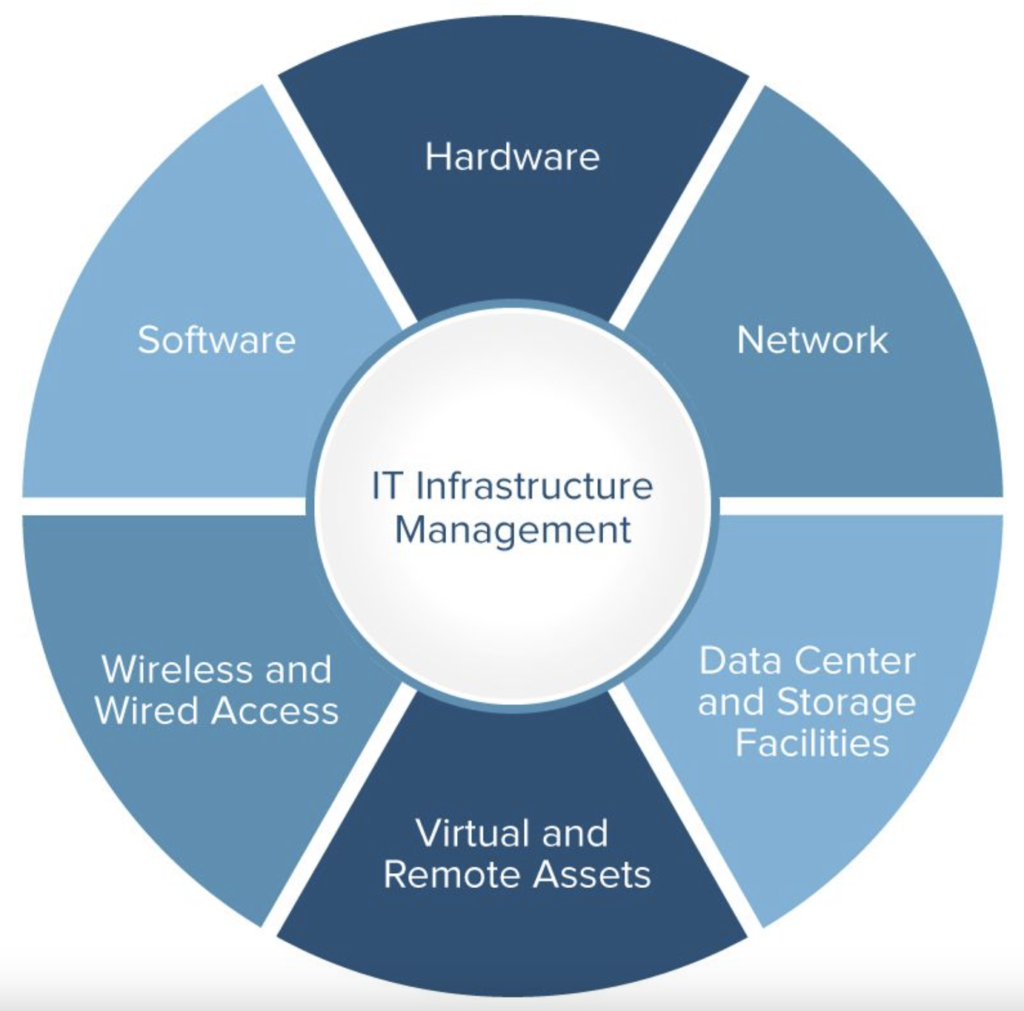
IT Infrastructure Management Process (Image by Zapier)

IT Infrastructure Management Process (Image by Zapier)
The IT infrastructure management process is about navigating the complex roadmap of setting up, maintaining, or upgrading IT environments.
The IT infrastructure management process is the organized way to design, build, and maintain your company’s technology backbone.
This process addresses the challenges management of the IT infrastructure, from planning to executing and monitoring tasks to ensure the IT infrastructure is perfectly aligned with an organization’s goals.
In this process, the emphasis is on clear communication, realistic timelines, and meticulous budget management, all aimed at delivering efficient, scalable, and secure IT solutions.
Such a methodical approach is crucial because it directly influences an organization’s operational fluency, risk management, and ultimately, its success in the digital landscape.
Managing IT infrastructure projects is a multifaceted endeavor, crucial for modern businesses. At its core, this process revolves around several key phases.
First, there’s project initiation – this is where objectives are set and the project’s feasibility is assessed.
It’s about laying the groundwork and getting a clear understanding of what needs to be achieved.
Next up, the planning phase. This phase is all about strategy – developing a detailed blueprint of how to reach the project goals. It includes defining the resources, timeframes, and steps required.
Then comes the execution phase. Here, the plans are put into action. It’s a dynamic phase where teams collaborate to build or enhance the IT infrastructure.
Monitoring is equally important. During this stage, the project’s progress is closely tracked. It’s about ensuring everything stays on track and adjusting plans as needed.
Finally, there’s project closure. This is where everything wraps up. The project is evaluated, lessons are learned, and the new or upgraded IT infrastructure is handed over.
Each of these components is vital to the IT infrastructure management to ensure projects are completed efficiently, on time, and within budget.
The initiation phase is the first step in the IT infrastructure project management process.
The goal of this phase is to make informed decisions and lay a solid foundation for the project.
This ensures that the project is not only feasible but also strategically sound and aligned with the organization’s vision.
This phase is fundamental to the success of the entire project. To achieve this, a logical sequence of steps must be followed to set the stage for everything that follows.
During this phase, it is important to set clear, achievable goals. This is not just about identifying what needs to be built or improved, but also understanding the reasons for doing so.
The objectives should align with the broader goals of the organization to ensure that the project adds real value.
Additionally, conducting a feasibility study is a cornerstone of this phase. This study involves a thorough examination of the project’s financial, technical, and operational viability.
This study examines the potential impact on current systems, required investment, and anticipated returns. It also evaluates risks and identifies potential challenges.
The planning phase is where the vision takes shape. Here, defining the project’s scope is essential.
The planning phase involves detailing what the project will and won’t include, setting boundaries to maintain focus.
Resource allocation is another crucial aspect. This step is about ensuring that the right people, equipment, and materials are in place, aligned with the project’s needs and timeline.
Establishing a timeline is about creating a realistic schedule that outlines key milestones and deadlines.
It’s a balancing act between ambition and practicality, ensuring the project progresses without undue delays.
Risk management, integral to this phase, involves identifying potential obstacles and developing strategies to mitigate them.
It’s about foreseeing what could go wrong and planning accordingly. Effective risk management is vital for minimizing surprises and keeping the project on track, ultimately playing a significant role in its success.
The execution phase of IT infrastructure project management is where plans are put into action.
This stage involves implementing changes or enhancements to the IT setup, including the physical deployment of hardware, software installation, and system configuration.
Everything starts to come together in the hands-on part of the project.
During this phase, team mobilization is a decisive element. Effective execution depends on the skills and efforts of a dedicated team, with each member playing a specific and vital role.
Coordinating these efforts is central to ensuring that everyone is working toward the same goals.
This communication is the glue that holds the project together, keeping everyone informed, aligned, and ready to tackle challenges.
Equally important is clear and ongoing communication among team members, stakeholders, and other departments.
This emphasis on teamwork and communication is crucial for successfully navigating the complexities of IT infrastructure projects.
During this phase, ongoing monitoring is critical to regularly track the project’s progress against its planned objectives.
This includes tracking timelines, budget expenditure, and resource utilization to ensure alignment with the plan.
Issue resolution is a key component, and challenges must be addressed swiftly to prevent delays or cost overruns.
This requires a proactive approach to identify issues early and implement effective solutions.
Quality control is essential to ensure that the project meets predefined standards and functions as intended.
Regular quality checks help identify discrepancies and areas for improvement.
Change management also plays a critical role in project success. As projects evolve, changes may be necessary, and it is essential to manage these changes effectively, ensuring that they are well documented, approved, and seamlessly integrated to maintain project integrity.

The closing phase is an important phase because the project is complete and is in a state of readiness for delivery.
The first step is to evaluate the project to ensure that all objectives have been met and that the final product is consistent with the original requirements.
This requires a thorough review of the project’s trajectory from initiation to completion.
Additionally, comprehensive documentation of the project, including strategies employed, challenges faced, and solutions implemented, is essential.
This document is a useful resource for future projects, providing insights and lessons learned.
Client acceptance is critical as it confirms that the deliverables meet their expectations.
This stage often involves a formal handover of the completed infrastructure and a final sign-off.
Ensuring client satisfaction at this point highlights the project’s success and sets the stage for future collaborations.
The post-implementation review is an integral part of the IT infrastructure management process, offering a retrospective analysis once the project is completed.
This review focuses on evaluating the project results against initial objectives and expectations.
Here, you can ask: Did the project deliver the desired outcomes? Were the timelines and budget adhered to?
Gathering feedback is pivotal in this stage. Input from team members, stakeholders, and clients provides a multifaceted perspective on the project’s success and areas for improvement.
It’s about understanding different experiences and viewpoints to gain a comprehensive picture.
Documenting lessons learned is perhaps the most valuable outcome of this review. It involves recording successes and shortcomings, insights gained, and strategies that worked or didn’t.
This documentation is a goldmine for future projects, offering guidance and helping to refine processes for continual improvement.
The goldmine documentation turns experience into wisdom, crucial for evolving and enhancing future IT infrastructure projects.
Effective project management in IT infrastructure is akin to navigating a complex network.
Effective project management requires a blend of strategic planning, adaptability, and clear communication.
One of the best practices is prioritizing open and ongoing communication.
This involves regularly updating stakeholders on progress, addressing concerns promptly, and ensuring that everyone involved has a clear understanding of their roles and responsibilities.
At the same time, incorporating agile methodologies is another key practice.
Agile approaches, characterized by their flexibility and iterative nature, allow for more responsive and adaptive project management.
This is particularly valuable in IT, where requirements and technologies can change rapidly.
Agile methods foster a collaborative environment where feedback is actively sought and integrated throughout the project lifecycle.
Risk management is crucial also. Identifying potential risks early and having contingency plans in place can save considerable time and resources.
Effective risk management means continuously assessing potential hurdles throughout the project and being prepared to pivot strategies as necessary.
Finally, meticulous documentation cannot be overstated. Keeping comprehensive records of every phase of the project – from initial planning to final delivery – is essential.
This not only ensures transparency and accountability but also provides a valuable reference for future projects.
Good documentation captures decisions made, changes implemented, and lessons learned, creating a knowledge base that can drive continuous improvement in IT infrastructure project management.
It’s 2024 and we’re on a journey through the dynamic world of IT infrastructure management. And yes, the landscape is buzzing with opportunities and challenges.
Hopefully, our exploration above will guide you through the essential phases of IT infrastructure project management-from the spark of initiation to the final bow in the closing stages.
As we move forward in 2024, enhancing IT infrastructure management is not just beneficial; it’s essential.
This process is about aligning IT capabilities directly with business objectives.
It’s about clear, straightforward communication, strategic planning that adapts to real-world challenges, and proactive monitoring to ensure continuous improvement.
So, let’s focus on strengthening our IT infrastructure management.
By doing so, we ensure our businesses are equipped to handle the demands of the modern market, leading to improved efficiency, better risk management, and a stronger competitive edge.